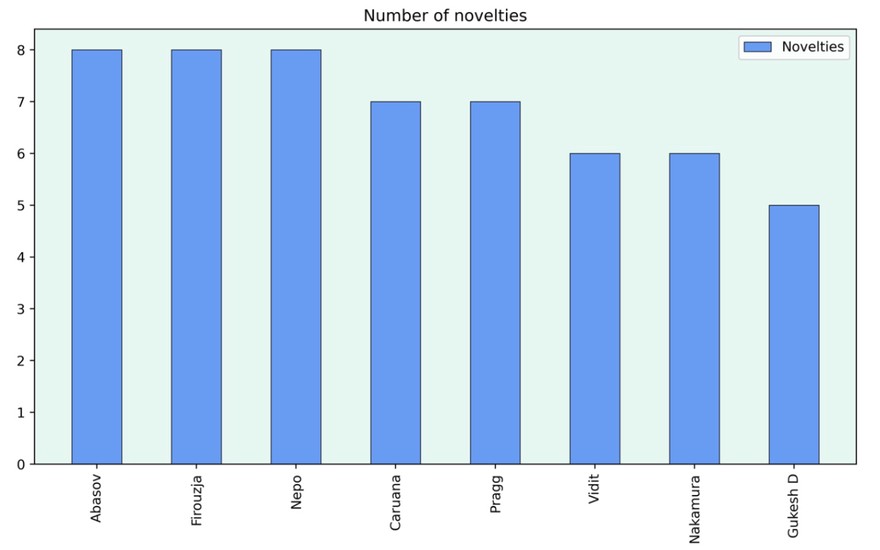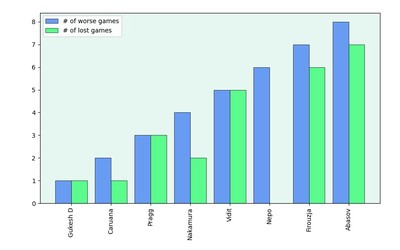
Opening novelty rates of the 2024 Candidates
Who played the most novelties in the Candidates?As mentioned in my post about the Candidates tournament, I’m interested in looking at the openings in top level tournaments. I finally found the time to look at the novelties from the Candidates and found the results quite intriguing.
But before looking at these results, we have to ask a more philosophical question.
What is a novelty?
Before asking myself this question, I thought that the definition of a novelty was straightforward: a new move in a game with some theoretical value to it.
But the more I thought about it, the fuzzier the definition seemed to become and before finding the novelties which were played, I needed to specify what exactly I was looking for.
When is a move “new”?
Before the internet and millions of online blitz and bullet games, only high level games got published. This made the definition of a new move easy. It was just that, a move that hasn't been played in a published game before.
But today millions of games are played each month online and so the question becomes which games to use for the comparison.
Of course, hardly anyone would include random bullet games from Lichess, but what about the bullet games of Carlsen? Probably also not.
What about Titled Tuesday? What about OTB blitz or rapid games?
I decided to only look at OTB classical games. This is obviously somewhat arbitrary, but the line has to be drawn somewhere. This is also more in line with the classical definition of a novelty.
I also decided to only include games where both players were rated above 2400. Again, there has to be some cutoff since not every game is relevant for the top level.
When is a new move good?
After figuring out when a move is new, the next question is whether this move is good enough to be counted as a novelty.
When talking about novelties, people used to mean moves that were objectively strong. But nowadays many top players prepare suboptimal moves in order to get a playable position or to get their opponent out of prep. So not every suboptimal move can be excluded but at the same time, serious inaccuracies shouldn't be counted as novelties.
Again, there needed to be a somewhat arbitrary cutoff and I decided to only include moves with a centipawn loss of less than 70. This might be a bit high, but as we have seen in the Candidates (for example in the game Vidit-Pragganandhaa) top players are willing to take quite big risks in the opening.
Novelty Stats
Now that we got the questions regarding the definition of novelties out of the way, it's time to look at the results.
First I looked at the number of novelties each player has played in the Candidates.
It's interesting to see that they are all quite similar and that Gukesh as the eventual winner played the least new moves. I also wouldn't have expected Abasov to place so highly, but this may just be ignorance on my part.
Since there were 14 games, Abasov, Firouzja and Nepo played a novelty on more than half their games. This means that they more often than not were the first players to deviate from known theory. By counting all games with novelties, one can also see that there was a game without a novelty which was the Firouzja-Vidit Berlin draw in the last round.
Book Moves
After seeing the number of new moves, I thought that it might also be interesting to see which players chose rare lines.
To do this, I looked at how often the positions in the opening appeared in my database. I split them into 5 groups: more than 10000, 1000, 100, 10 and 1 games. I divided the total number of moves by the number of games in order to get the average number of moves per game.
There is a lot of information in this plot and I'm not sure which group of games is the most meaningful to look at.
When looking at the number of moves where the players were in known territory (so more than 1 game in the database), the results confirm my intuitive feeling about which players play more book moves. Especially the fact that Nepo played a lot of known moves since his approach with Black was to stick to his Petroff and that Firouzja played the least amount of known moves.
Conclusion
I'm quite pleased with the results, but as always, there are some things that could be changed.
As mentioned before, all my cutoffs are completely arbitrary, so these values could all be changed. However, it's quite difficult (maybe even impossible) to determine values that are best in each situation. There are so many different possibilities that one simply has to make compromises.
One improvement would be to judge the value of a new move in a more sophisticated way than just looking at the centipawn loss. But classifying which ideas are interesting for human players is very difficult, so I left this task for a later date.
Another possibility to determine whether a player is in their preparation (and therefore plays a theoretical novelty) would be to look at the time used per move. I decided against this since it's unclear how long a player needs to think in order to say that they aren't in their preparation anymore. For example, Vidit always paused for a couple of minutes before the first move in the Candidates, but he obviously wasn't out of book on move one. So finding a balance for the time a player needs to take before we say that they aren’t in their preparation is quite difficult.
I’m interested to hear what you think about my choices for the cutoffs and the results I’ve gotten.
If you've enjoyed this post, check out my Substack.
More blog posts by jk_182

Comparing Stats from Erigaisi's Open and Closed Tournaments
Recently, I got very interested in the play of Arjun Erigaisi, not only because he made the jump int…
Testing Maia's Puzzle Performance
How strong are the Maia engines when solving tactics?
The Candidates in 13 Graphs
Looking at stats from the 2024 Candidates tournament